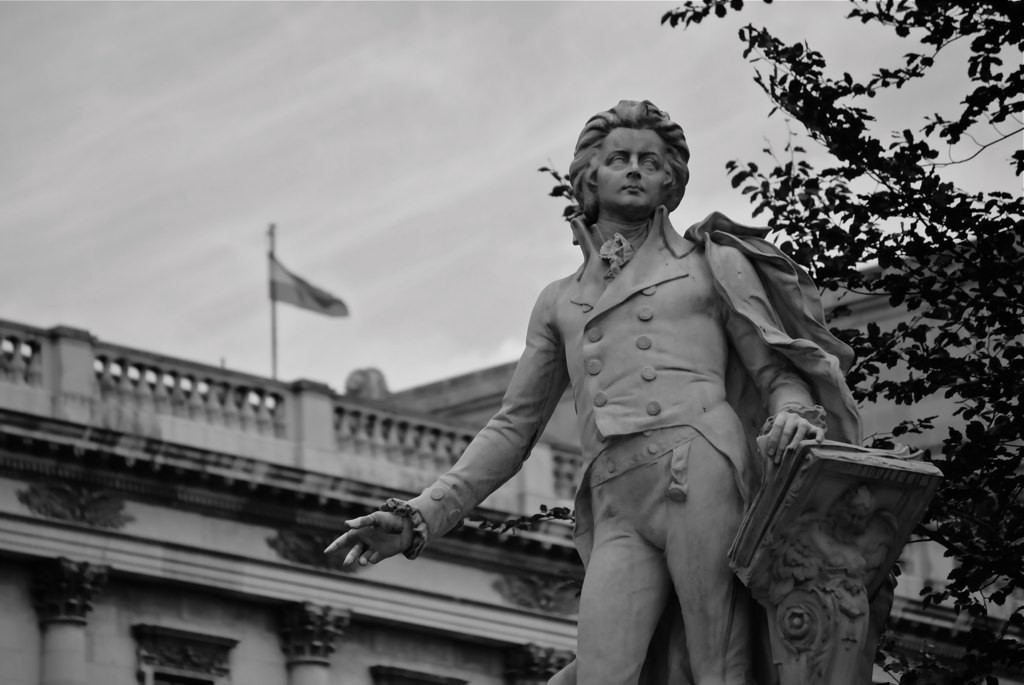Mozart is the Justin Bieber of Classical Music
Classical Music Hour with Fran

It’s inarguable that you haven’t heard of Wolfgang Amadeus Mozart, either from his music or the movie Amadeus or just from being alive as a person. Mozart! He’s world-famous. A young prodigy who took the world by storm and had issues with his father. The Justin Bieber of classical music (I’m not kidding about this).
Having a favorite Mozart piece is like picking a favorite piece from an extremely young Canadian pop star who has suffered some very public meltdowns but always seems to come out with better and better albums: impossible. What’s your favorite Mozart piece? Is it Eine Kleine Nachtmusik? Is it The Magic Flute? Is it the friggin’ Overture to The Marriage Of Figaro? It could be anything feasibly, because Mozart is that good and his music is everywhere. In that case, I ought to share mine, which is, don’t laugh: Symphony №29 (Berliner Philharmoniker, 1992).
I mean, listen, just listen to this first movement, the Allegro Moderato (“relatively fast”). Is it not just the nicest thing? I’ve previously characterized Tchaikovsky as the king of melody, and I’m standing by that 100%, but Mozart is the king of nice. His music is easy and clear and uncomplicated. Keep in mind that Mozart was composing long before a lot of the other composers I’ve written about, so his music is really just playing with themes and variations on instrumentation, not so much grandiose scenes or stories. And the result is profoundly pleasant!
Even the Andante, its slower second movement, isn’t like the lengthy, mournful Andantes (or Largos) of symphonies past. This is pure nap music if I’ve ever heard it, and I mean that in a profoundly respectful way. This is conflict-free. You don’t have to think twice about it. Mozart has tapped directly into your neurons and told you to chill the hell out. All of this is very “the Austrian countryside on a nice summer afternoon,” which is why I’m introducing it to you in the dead of January.
The Menuetto and Allegro con spirito (“quickly, with spirit”) are Symphony №29’s shortest movements, but they’re also distinctive. The Menuetto doesn’t really bang as much as a traditional minuet kind of can — minuets are typically the dance movement — but its final thirty seconds bring in some heavy cellos to do a lot of heavy lifting. It’s plenty upbeat, ending on a little fanfare that kicks into the final movement which is the undoubted banger of this symphony. The Allegro con spirito is so playful and genuinely exciting. That’s the thing about Mozart: he can make listening to something so cheerful exciting without any type of stressful tension. Its conclusion is spirited — Allegro con, oh, I get it! — and ends with this big run on the strings before its final two notes. How do you not love it?
There’s nothing too astonishing about this symphony, unless you count the fact that Mozart wrote it when he was eighteen years old. Literally what were you doing when you were eighteen years old? Bieber was putting out Boyfriend, which, look, we all make mistakes. I was having my first vodka cranberry and dancing to this song in the basement of a house occupied by my liberal arts college’s Model U.N. team. Regardless, it’s a nice thing to listen to. I don’t know how it cemented its place as my favorite, especially when there are truly so many to choose from, but I love this contribution of teen Mozart’s to the world of classical music. You deserve an underrated gem.
Fran Hoepfner is a writer from Chicago. You can find a corresponding playlist for all of the pieces discussed in this column here.
